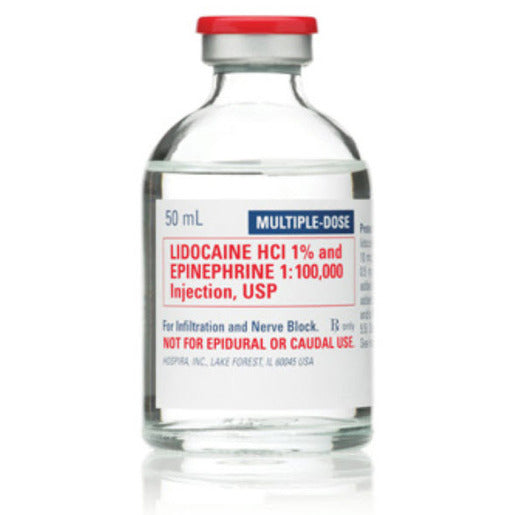Lidocaine 1% and Epinephrine 1% Injection 1:100,000, 500 mg/50ml, 50 mL Multiple Dose vials 25/Tray (Rx)
(Note: We don’t Fill Personal Prescriptions)
How to Order:
Lidocaine 1% and Epinephrine 1:100,000 Injection (500 mg/50 mL, 50 mL) is used as a local anesthetic to manage pain and control bleeding during surgical, dental, and medical procedures. Lidocaine acts by blocking nerve signals, providing numbness and reducing discomfort. Epinephrine, as a vasoconstrictor, prolongs the anesthetic effect and decreases bleeding by constricting blood vessels. This combination is highly effective for procedures where extended anesthesia and minimal bleeding are critical, optimizing surgical field visibility and enhancing patient comfort.
Active Ingredients:
Lidocaine Hydrochloride: Present at a concentration of 10 mg/mL (1%), acts as a local anesthetic.
Epinephrine: Available at a ratio of 1:100,000, serves as a vasoconstrictor.
Concentration and Formulation:
Lidocaine Concentration: 1% (10 mg/mL)
Epinephrine Concentration: 1:100,000
Packaging:
Volume: 50 mL per vial
Type: Multiple-dose glass vial
Package Configuration: Available in trays, with 25 vials per tray.
Indications:
-
Local or Regional Anesthesia: Used in various surgical and dental procedures to numb a specific area while decreasing blood flow to the site, aiding in field clarity and reducing systemic absorption.
- Prolongation of Effects: The addition of epinephrine helps in prolonging the anesthesia effect by slowing lidocaine absorption into the bloodstream.
Administration:
Typically administered via infiltration or nerve block techniques by healthcare professionals.
Safety and Precautions:
-
Contraindications: Known hypersensitivity to amide-type local anesthetics and epinephrine-containing products.
-
Warnings and Precautions: Careful monitoring is required to avoid systemic toxic reactions to lidocaine and cardiovascular reactions due to epinephrine. Use cautiously in patients with cardiovascular disease or those taking MAO inhibitors or tricyclic antidepressants.
- Adverse Reactions: Though generally well-tolerated, may cause localized reactions like redness or swelling, and rarely systemic responses like heart palpitations or serious allergic reactions.
Storage:
- Store at controlled room temperature and protect from light. Do not freeze.
This combination injectable is pivotal in ensuring effective local anesthesia with reduced bleeding and prolonged anesthesia duration, adding significantly to procedural success while prioritizing patient comfort and safety.

